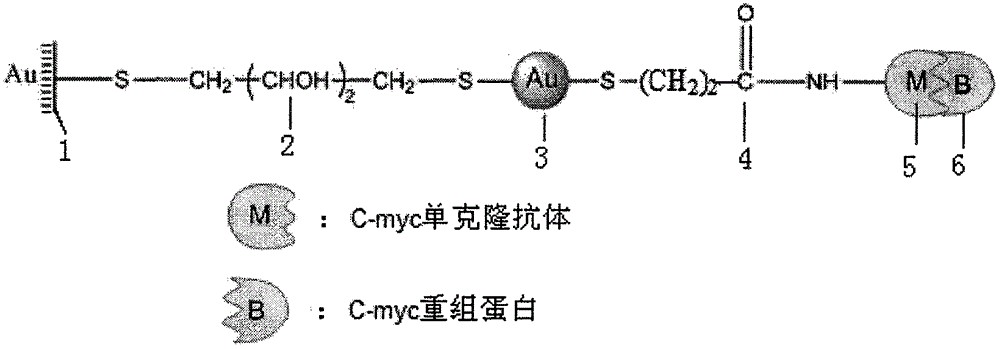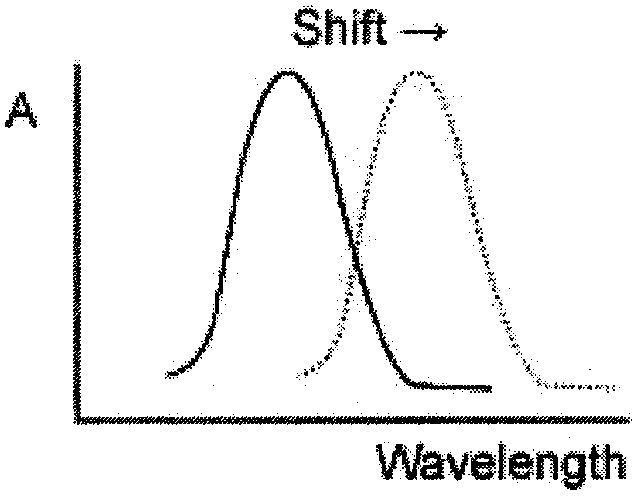LSPR (Localized Surface Plasmon Resonance) sensing chip for detecting recombinant protein of carcinogene C-myc
A sensor chip and recombinant protein technology, which is applied in the field of protein content detection in tumor cells, can solve the problems of application limitations, cumbersome operation, and low precision, and achieve the effects of good selectivity and reproducibility, simple assembly, and rapid quantification
- Summary
- Abstract
- Description
- Claims
- Application Information
AI Technical Summary
Problems solved by technology
Method used
Image
Examples
Embodiment 1
[0017] Assembly preparation of LSPR sensor chip:
[0018] 1) A layer of 100nm gold film was coated on the surface of polystyrene plastic and silicon oxide glass substrate by magnetron sputtering coating method, and the vacuum degree of the coating film was controlled to be 1.0×10 -4 Pa, the coating speed is Make the surface of the gold film smooth;
[0019] 2) Add Piranha solution (Note: Piranha solution is a solution of concentrated sulfuric acid:hydrogen peroxide = 7:3) dropwise on the surface of the above-mentioned gold film for 15 seconds, take it out and rinse it repeatedly with twice distilled water for 3 times;
[0020] 3) Soak the gold film treated in the above steps in absolute ethanol and double distilled water for 60 seconds;
[0021] 4) Immerse the gold film treated in the above steps in a 50mmol / L DTT solution, place it for 10h to form a DTT monolayer, rinse it with absolute ethanol three times to remove the free DTT on the surface, and then rinse it repeatedly...
Embodiment 2
[0027] Determination of C-myc recombinant protein standard curve:
[0028] 1) The reagents used (double distilled water, PBS buffer solution) were sterilized and stored at 4°C for later use;
[0029] 2) Take 1μLC-myc recombinant protein (antigen) and place it in a 1.5mL small test tube, use PBS as the buffer solution, dilute it by 1-100000 times respectively, and prepare a series of solutions of 0-6.5μg / mL for later use;
[0030] 3) The LSPR sensor chip modified with the above-mentioned C-myc monoclonal antibody was used to test the C-myc recombinant protein samples of various concentrations, and the combination of the C-myc monoclonal antibody and the C-myc recombinant protein immune reaction caused the gold on the chip to The absorption peak of the localized surface plasmon resonance spectrum of nanoparticles shifts red, and the peak shift has a linear response relationship with the content of C-myc recombinant protein; The displacement value Δλ (nm) is the ordinate, and th...
Embodiment 3
[0033] Determination of C-myc recombinant protein content in liver cancer tissue:
[0034] Extraction of protein in tissue: take 0.1g tissue sample, rinse with pre-cooled PBS at 4°C to remove tissue foreign matter. Cut to 0.5mm with scissors 3 Small pieces were added to the prepared 1.0mL lysate, and then diluted with PBS for later use.
[0035] Determination of C-myc recombinant protein content: place the LSPR sensor chip prepared above in PBS buffer solution, first record the reading λ of the absorption peak wavelength position of PBS buffer solution 1 = 353.47nm. Take the above-mentioned diluted sample solution for measurement, and record the reading λ of the absorption peak wavelength position 2 = 354.68nm. The absorption peak displacement value (from, nm) of this sample can be obtained by following formula: Δλ=λ 2 -λ 1 , Substituting Δλ into the fitted standard curve equation, the concentration of C-myc recombinant protein in the liver cancer tissue sample can be calc...
PUM
| Property | Measurement | Unit |
|---|---|---|
| thickness | aaaaa | aaaaa |
| particle diameter | aaaaa | aaaaa |
| adsorption capacity | aaaaa | aaaaa |
Abstract
Description
Claims
Application Information
 Login to View More
Login to View More - Generate Ideas
- Intellectual Property
- Life Sciences
- Materials
- Tech Scout
- Unparalleled Data Quality
- Higher Quality Content
- 60% Fewer Hallucinations
Browse by: Latest US Patents, China's latest patents, Technical Efficacy Thesaurus, Application Domain, Technology Topic, Popular Technical Reports.
© 2025 PatSnap. All rights reserved.Legal|Privacy policy|Modern Slavery Act Transparency Statement|Sitemap|About US| Contact US: help@patsnap.com



